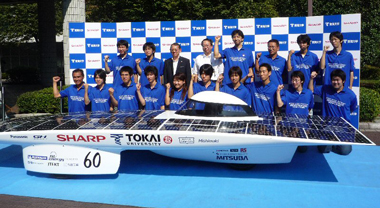
| Home | About Us | Contribute | Bookstore | Advertising | Subscribe for Free NOW! |
| News Archive | Features | Events | Recruitment | Directory |
| FREE subscription |
| Subscribe for free to receive each issue of Semiconductor Today magazine and weekly news brief. |
News
8 September 2009
Tokai University completes solar car with Sharp III-V solar cells
Japan’s Tokai University has completed construction of its ‘Tokai Challenger’ solar car, which will be used from 24-31 October in the Global Green Challenge (one of the world’s largest solar car races, formerly the World Solar Challenge).

Picture: Tokai Challenger solar car, powered by Sharp Corp's triple-junction compound semiconductor solar cells.
The race’s solar car category has vehicles powered only by the sun’s energy crossing the Australian continent from Darwin to Adelaide (about 3000km). Tokai University drivers include Kenjiro Shinozuka (who in 1997 became the first Japanese to win the Paris to Dakar Rally overall) as well as university students and alumni.
The Tokai University Challenge Center Team consists of 19 members (mostly students) led by professor Hideki Kimura, who researches high-efficiency solar cars at the School of Engineering’s Department of Electrical and Electronic Engineering. The team has previously crossed the Australian desert three times—in 1993, 1996, and 2001—for the World Solar Challenge. In 2008, with Shinozuka as driver, the team won the 4200km South African Solar Challenge.
To maximize performance under the harsh conditions of the race, the Tokai Challenger is covered not with silicon solar cells but with triple-junction compound semiconductor solar cells - using indium gallium phosphide (InGaP), indium gallium arsenide (InGaAs) and germanium (Ge) for the top, middle and bottom layers, respectively. They are made by Tokyo-based electronics firm Sharp Corp, the only manufacturer whose solar cells are approved for use by the Japan Aerospace Exploration Agency (JAXA). Originally developed for space applications (sealed with glass to make a module), they are instead sealed with a film to enable mounting on curved surfaces and to minimize weight.
With a solar energy conversion efficiency of 30%, the 2176 cells (which measure 77mm x 39mm each) cover 6m 2 in total and provide power output of 1.8kW.
Sharp says that, despite crystalline and thin-film silicon solar cells currently being its main solar power products, it aims to continue its progress in R&D on compound semiconductor photovoltaics.
![]() Search: Triple junction solar cells InGaP InGaAs Germanium
Search: Triple junction solar cells InGaP InGaAs Germanium
Visit: www.globalgreenchallenge.com.au
Visit: www.sharp.co.jp